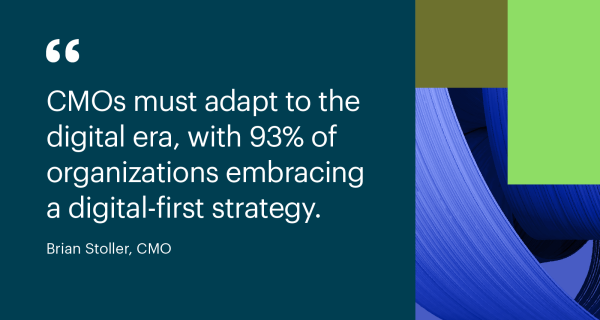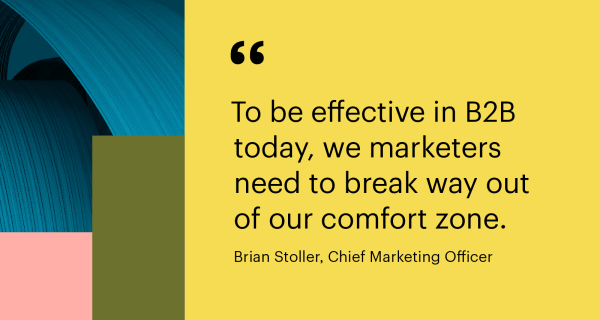Marketing budgets have taken a hit in 2023. Looking ahead, many CMO’s are reporting that their budgets will likely stay the same or decrease. Making the focus on the most efficient tools, data, channels, and process for hitting goals crucial.
What marketing channels should you be focusing on, and what tools are available within each of those channels to make the most out of them?
Understanding a CMO’s metrics
CMOs pay close attention to the key metrics that reflect progress towards overarching goals to ensure they’re getting the most out of their investments. When evaluating channels, each metric is broken out into finer, diagnostic details.
Being specific and realistic about your metrics and benchmarks will help you implement and evaluate an effective marketing strategy.
Brand awareness and brand equity
Brand awareness comes before the first stage of customer acquisition. Your prospects need to not just know you exist but trust you as a reliable and valuable partner so that they remember you when a pain point does arise.
At the surface level, your logo, tagline, and personality need to be consistent across all channels and should help give your prospects a clear feeling of what it would be like to work with you. But it takes more than a cohesive visual style, brand storytelling plays a key role in building audience connections.
Position yourself as a trusted resource for content, blogs, and webinars and develop a relationship with potential clients. That way, they’ll know they can turn to you to help them uncover solutions to their challenges.
Measure your brand equity through:
- Web traffic: Are people consistently visiting and revisiting your website, and spending time there exploring your content?
- High-quality social shares: When you promote content on social media, do people share it with their networks or engage in dialogue? Are they referencing your resources?
- Conversions: When someone comes upon your content and brand, do they convert to social media follower or newsletter subscriber? Do they exchange their contact information to access your resources?
Return on investment (ROI)
How is each channel living up to the price tag of its investment? As a CMO, you have to prove to the rest of your team that your budget is paying dividends. This metric applies to individual channels, technology investments, and the overall marketing team resources. Careful record keeping, connected data, and activity analysis are key here.
Measure your ROI though:
- ROI = (Sales Growth – Organic Sales Growth – Marketing Cost)/ Marketing Cost
- Set time-constrained goals for each channel to help determine ROI. Since customer journeys can be long, include steps along the way in your goals for more precise tracking. For example, how many MQLs, SQLs, meetings, or customers do you need to earn for a channel or tactic to pay for itself?
Customer acquisition cost (CAC)
CMOs need to know the cost of closing a deal. Ideally, you want your CAC to be lower than your average deal size. If your CAC is significantly higher than your average deal size, it might indicate that your marketing efforts are not generating enough value to cover the cost of acquiring customers. While there’s no universal benchmark multiplier for CAC it’s important to understand what’s considered a reasonable CAC for your industry. Benchmarking can give you a rough idea of where your CAC should ideally fall relative to your average deal size. Assess the CAC across various marketing channels and maintain regular monitoring of each channel’s performance.
Measure your CAC through:
- CAC = Sales + Marketing expense/Number of customers
- Online conversion rates
Customer lifetime value (CLV)
This is the loyalty stage. CLV is the total revenue you can expect from a single client account over the lifetime of that account. The longer you retain a client, the larger the CLV. Use this metric to identify which customer segments provide the most ROI and that you should be spending most of your focus on.
Measure your CLV through:
- CLV= (Average purchase value X Average purchase frequency rate) X Average customer lifespan
- You can also consider CLV in relation to CAC. CLV represents the total value a customer generates for your business over their entire relationship with you, while CAC measures the cost of acquiring a customer. Comparing CLV and CAC is crucial for making informed decisions about your marketing and business strategies. Ideally, you want your CLV to be significantly higher than your CAC, ensuring that you’re not only covering your customer acquisition costs but also generating sustainable profits over the long term.

Marketing channels
With an understanding of the key metrics, it’s time to look at a few of the marketing channels marketing teams invest time, energy and budgets into. Each of these channels presents distinct advantages, specific performance indicators, requisite tools, and optimization costs. So, how do you choose your marketing mix, get set up for success, and optimize accordingly?
Organic search
Increasing the number of people seeing and visiting your website organically should be one of your top priorities. Your website is where your high-quality content lives, and where you have the best opportunity to connect with prospects and evaluate their behavior.
A strong organic search channel is based on setting up content and website elements to attract organic (non-paid) web traffic to help you land at the top of the search engine results page (SERP). The tactic to get you there is search engine optimization (SEO), driven by elements like keywords, backlinks, on-site topics, relevance, and even local and international components.
Why might marketers consider investing in organic search? Organic search is a great way to:
- Increase your website traffic
- Improve brand visibility
- Boost conversions and engagement
- Gain long-term benefits
Organic search is considered a relatively inexpensive way to boost marketing efforts without direct advertising costs. But it still requires a strategic approach. Organic search performance involves investment in time, effort, and potentially some tools or expertise. The long-term benefits of organic search optimization make it an attractive option for many businesses looking to boost their marketing efforts on a budget.
Benchmarking and measuring organic search
These metrics provide quantitative data that allow you to understand, benchmark, and measure how your website is performing in search engine results and how users are interacting with your content.
- Organic traffic
- Keyword rankings
- Click-through rates (CTR)
- Conversion rates
- Average time spent on page
- Average pages per visit
- Organic page rank
Organic search tools
Here are a few common organic search tools that marketers can invest in to optimize their organic search efforts and performance:
Keyword research tools: These tools help identify relevant keywords and search terms that users are entering into search engines.
SEO analytics and tracking tools: These tools provide insights into your website’s performance and how it’s ranking in search results. They often offer data on traffic, keyword rankings, and more.
Competitor analysis tools: These tools help you understand your competitors’ online strategies, including keywords they are targeting, backlinks they have, and more. This information can guide your own organic search efforts.
Paid search
While organic SEO can take time to build, paid search results help guarantee your business appears at the top of the organic results right away – but only for as long as you pay for the ad. Paid search is paid placements that appear alongside and/or above organic search results. These campaigns are based on keywords you bid on so your business or content can appear higher within search results. However, SEO still influences the visibility of your paid ads through quality scores that evaluate factors such as relevance and keywords.
A bid is the maximum amount of money you’re willing to pay for a specific keyword. Placement is based on these bids and reflects your visibility in search results. Paid search is unique compared to other marketing channels because it is pretty much all text, with very little to no imagery, and is based on user actions (searching for terms), so it has higher relevance to users by design.
Why might marketers consider investing in paid search? Paid search is a great way to:
- Gain immediate visibility
- Target your audience reach
- Improve your brand awareness and visibility
- Reach a high-intent audience
Unlike organic search, paid search requires a direct advertising cost and budget allocation. Despite the cost, paid search can is a great way to earn immediate visibility and yield positive results through increased traffic and conversions.
It’s essential to carefully plan, set budgets, monitor performance, and optimize campaigns to ensure you’re getting a solid return on your investment.
Benchmarking and measuring paid search
Measuring and benchmarking paid search effectively is crucial to understanding the performance of your campaigns and making informed decisions for optimization.
A few metrics essential to track when investing in paid search are:
- Click-through rates (CTR)
- Conversion rates
- Cost per click (CPC)
- Ad position
- Cost per conversion
The metrics and benchmarks are relatively the same with paid search as they are with organic search. However, with paid search, you’re often targeting people who are further along in the journey with high purchase intent, which means that paid search should provide a quicker ROI. You also have the option to categorize keywords and campaigns based on intent levels, driving prospects to specific content, conversations with sales, or branded keywords.
Paid search tools
Here are a few common paid search tools that marketers can invest in to optimize their paid search efforts and performance:
Bid management software: Bid management software is a tool that automates and optimizes the process of adjusting bids for paid search campaigns, helping achieve better results and cost efficiency.
Competitor analysis tools: Allows you to research competitor keywords, ad copy, and ad spend on both Google Ads and Bing Ads.
Ad campaign management platforms: Tools that assist advertisers in creating, organizing, and optimizing their paid search advertising campaigns across multiple search engines. Examples include Google Ads and Microsoft Advertising.
Email marketing
Email marketing allows organizations to put themselves in prospects’ and existing clients’ workdays with targeted messaging and special high-value offers. Email lets you experiment with subject lines, delivery times and days, and messaging, while segmenting your audience based on context, personas, and buying stages.
Why might marketers consider investing in email as a marketing channel? Email marketing is a great way to:
- Directly communicate with prospects and customers
- Segment and personalize content
- Nurture leads
- Automate outreach
Marketers mostly use their own websites, blogs, and email to distribute content, making it one of the more common channels. Email marketing shows one of the highest returns on investment (ROI) among digital marketing channels, in fact the average ROI through email marketing is $36 for every $1 spent. With a relatively low cost compared to other channels, the potential for generating revenue is substantial. While email marketing is cost-effective, there are still initial setup costs associated with choosing and setting up an email marketing platform, and other tools to help execute your strategy.
Benchmarking and measuring email marketing
With an effective email strategy, you can move people through the customer journey by providing them with content and resources they need. Evaluating email marketing as a marketing channel involves analyzing the performance of your email campaigns to determine their effectiveness in achieving your marketing goals.
Here are a few of the metrics essential to tracking the success of email marketing channels:
- Open rate
- Click-through-rate
- Conversion rate
- Bounce rate
- Unsubscribe rate
Email marketing tools
Here are a few common email tools that marketers can invest in to optimize their email marketing efforts and performance:
Email marketing platforms: These are comprehensive tools that provide features for creating, sending, and tracking email campaigns. They often include customizable templates, list management, segmentation, automation, A/B testing, and analytics. Popular platforms include MailChimp, Constant Contact, and HubSpot.
Marketing automation platforms: These platforms allow you to set up automated email workflows based on user behavior and triggers. They can send personalized emails at specific times, based on actions taken by subscribers. Popular platforms include HubSpot and Marketo.
Organic social media
75% of B2B buyers and 84% of C-Level/VP Executives surveyed use social media to make purchasing decisions
B2B buyers probably won’t click to purchase the first time they encounter your brand through a post or ad. But if you use it correctly, social media builds your brand equity and prospects will remember you when they are in search of a solution you provide. Channels within social media consist of Facebook, X (formerly Twitter), Pinterest, Reddit, and Instagram, although the most popular among B2B channels being LinkedIn.
Why might marketers consider investing in organic social media as a marketing channel? Organic social media is a great way to:
- Build brand awareness
- Interact and engage with your audiences
- Open two-way communication
- Emotionally connect through storytelling
- Tune into social listening – monitor competitors, watch for trends in your market, and gain insight into what your ICP cares and talks about.
Unlike paid advertising, organic social media doesn’t require a significant financial investment to get started. It’s a budget-friendly way to reach and interact with your audience, making it ideal for businesses with limited resources. However, seeing results with organic social media may take a longer time to yield successful results. Building a substantial organic following takes time, especially if you’re starting from scratch.
Benchmarking and measuring organic social media
Social media is your opportunity to humanize your brand and create an online presence that is personable and memorable. This is also where you can share your content marketing pieces that lead social media users to your website or to sign up for your email newsletter. Measuring success will follow two lines: how much people value your social media contributions and how often they’re converting.
Here are a few of the metrics essential to tracking the success of marketing efforts on organic social media channels:
- Engagement rate
- Reach
- Follower growth
- Site traffic
- Conversion rates
- Audience alignment rate
For attribution purposes, using tracking methods such as UTMs is important to measure any traffic that might be driven from organic social efforts.
Organic social media tools
Here are a few common organic social media tools that marketers can invest in to optimize their organic social efforts and performance:
- Content planning and scheduling tools: Streamlines the process of creating, organizing, and automating the distribution of social media posts across various platforms.
- Content creation and design tools: Enables users to produce visually engaging and professional-quality graphics, images, videos, and other multimedia assets.
- Social listening and monitoring tools: Track and analyze online conversations and mentions, allowing businesses to gain insights into audience sentiment, industry trends, and brand perception across social media platforms
Paid social
Use paid social to strengthen your social media presence. You can pay to display advertisements (PPC) or sponsored messages to target specific audiences. Paid social lets you segment audiences based on microtargeting and reach people beyond your followers and their friends.
Paid social offers a range of benefits that make it an exciting investment for marketers such as:
- Reinforcing messages that you’ve shared organically
- Micro targeting based on self-identified interests, locations, and demographic information
- Remarketing – promoting relevant content to people who have already visited your website
- Quick results and ROI
- Developing and promoting a LinkedIn influencer marketing strategy
Paid social media compared to organic, can offer quick ROI and results. However, it is a more expensive investment due to advertising costs. The best and most cost-efficient approach depends on your business goals, target audience, industry, and available resources.
Benchmarking and measuring paid social
The metrics are the same as organic social media, but just like with paid search you expect a faster ROI. With microtargeting, you can reach prospects with higher intent to purchase and can expect to close deals faster.
Paid social media tools
Tools used to invest in organic social media will be the same as tools used to invest in paid social media. The difference will be the cost of advertising spend. However, there are specific platforms that offer avenues for promoting your content to a targeted audience on social media.
Intent data
While not a channel, intent data is one of marketer’s biggest tools. Intent data can be used to optimize the performance of each of these channels covered. In fact, 95% of marketers use more than one source of intent data in their marketing efforts, and 93% report using intent across multiple channels. Intent data reinforces your existing marketing strategy to make every effort more effective. Connect with prospective clients who are already “in-market” for your solution and personalize your messaging to speak directly to individuals and specific ICPs.
Intent data reinforces existing marketing channels by giving marketers a clearer picture of where prospects are in the customer journey. Used correctly, intent signals will help you curate messaging to target audiences and move them from awareness to loyalty. In fact, Foundry found that campaigns using intent-based targeting were 2.5x more efficient than campaigns using standard targeting dimensions. Each of the channels covered above can uniquely benefit from intent data integration:
- Organic social: Engage with prospects in a meaningful way. Build brand awareness.
- Paid search and paid social: Target custom ad audiences with solutions they’re already searching for and put yourself into their consideration.
- Organic traffic: Guide content strategy to build strong brand equity, guide user behavior, and help customers through the decision stage.
- Email: Segment Audiences and offer personalized messaging and solutions to move them through the customer journey.
Intent data tools
There are many intent data tools on the market to help marketers optimize their marketing channels. Here are a few crucial factors to keep in mind when evaluating data providers:
- Data quality and accuracy
- Data coverage and depth
- Integration options
- Data privacy and compliance (GDPR, CCPA)
Bonus free tool: IntentBot
IntentBot is your real-time intent search engine. Enter a domain and a topic, then hit “see results” to see who’s showing intent towards you, your competitors, or companies you’re just curious about. The best part? It’s ungated and free, so you can try intent and find buyers on your own terms.
The ultimate checklist for evaluating tools/vendors within various marketing channels
Your budget to spend, your choice of where to invest. You have the power as a buyer, use it to your advantage.
Don’t be afraid to ask hard-hitting questions when evaluating tools or vendors within marketing channels. Because most likely, to get budget approved for any new tool or vendor, you’ll need to convince senior management of the value of the investment.
To help you do so, we’ve included a checklist that covers essential questions and considerations you should be asking when selecting tools and vendors within different channels.







